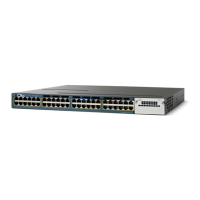1-6
Catalyst 3750-X and 3560-X Switch Software Configuration Guide
OL-25303-03
Chapter 1 Implementing IPv6 Multicast
Information About Implementing IPv6 Multicast
Rendezvous Point
IPv6 PIM provides embedded RP support. Embedded RP support allows the switch to learn RP
information using the multicast group destination address instead of the statically configured RP. For
switches that are the RP, the switch must be statically configured as the RP.
The switch searches for embedded RP group addresses in MLD reports or PIM messages and data
packets. On finding such an address, the switch learns the RP for the group from the address itself. It
then uses this learned RP for all protocol activity for the group. For switches that are the RP, the switch
is advertised as an embedded RP must be configured as the RP.
To select a static RP over an embedded RP, the specific embedded RP group range or mask must be
configured in the access list of the static RP. When PIM is configured in sparse mode, you must also
choose one or more switches to operate as an RP. An RP is a single common root placed at a chosen point
of a shared distribution tree and is configured statically in each box.
PIM DRs forward data from directly connected multicast sources to the RP for distribution down the
shared tree. Data is forwarded to the RP in one of two ways:
• Data is encapsulated in register packets and unicast directly to the RP by the first-hop switch
operating as the DR.
• If the RP has itself joined the source tree, it is multicast-forwarded per the RPF forwarding
algorithm described in the PIM-Sparse Mode section.
The RP address is used by first-hop switches to send PIM register messages on behalf of a host sending
a packet to the group. The RP address is also used by last-hop switches to send PIM join and prune
messages to the RP to inform it about group membership. You must configure the RP address on all
switches (including the RP switch).
A PIM switch can be an RP for more than one group. Only one RP address can be used at a time within
a PIM domain for a certain group. The conditions specified by the access list determine for which groups
the switch is an RP.
IPv6 multicast supports the PIM accept register feature, which is the ability to perform PIM-SM register
message filtering at the RP. The user can match an access list or compare the AS path for the registered
source with the AS path specified in a route map.
PIMv6 Anycast RP Solution Overview
The anycast RP solution in IPv6 PIM allows an IPv6 network to support anycast services for the PIM-SM
RP. It allows anycast RP to be used inside a domain that runs PIM only. This feature is useful when
interdomain connection is not required. Anycast RP can be used in IPv4 as well as IPv6, but it does not
depend on the Multicast Source Discovery Protocol (MSDP), which runs only on IPv4.
Anycast RP is a mechanism that ISP-based backbones use to get fast convergence when a PIM RP device
fails. To allow receivers and sources to rendezvous to the closest RP, the packets from a source need to
get to all RPs to find joined receivers.
A unicast IP address is chosen as the RP address. This address is either statically configured or
distributed using a dynamic protocol to all PIM devices throughout the domain. A set of devices in the
domain is chosen to act as RPs for this RP address; these devices are called the anycast RP set. Each
device in the anycast RP set is configured with a loopback interface using the RP address. Each device
in the anycast RP set also needs a separate physical IP address to be used for communication between
the RPs.
The RP address, or a prefix that covers the RP address, is injected into the unicast routing system inside
of the domain. Each device in the anycast RP set is configured with the addresses of all other devices in
the anycast RP set, and this configuration must be consistent in all RPs in the set.

